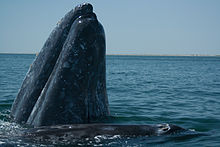
Back Eschrichtius robustus AN حوت رمادي صلب Arabic حوت رمادى صلب ARZ Megol (Eschrichtius robustus) AVK Сив кит Bulgarian Balum gris Breton Balena grisa Catalan Eschrichtius robustus CEB Plejtvákovec šedý Czech Morfil Llwyd Welsh
| Gray whale[1] Temporal range:
| |
|---|---|

| |
| Gray whale spy-hopping next to calf | |

| |
| Size compared to an average human | |
| Scientific classification | |
| Domain: | Eukaryota |
| Kingdom: | Animalia |
| Phylum: | Chordata |
| Class: | Mammalia |
| Order: | Artiodactyla |
| Infraorder: | Cetacea |
| Family: | Eschrichtiidae |
| Genus: | Eschrichtius |
| Species: | E. robustus
|
| Binomial name | |
| Eschrichtius robustus Lilljeborg, 1861
| |

| |
| Gray whale range | |
| Synonyms | |
| |
The gray whale (Eschrichtius robustus),[1] also known as the grey whale,[5] gray back whale, Pacific gray whale, Korean gray whale, or California gray whale,[6] is a baleen whale that migrates between feeding and breeding grounds yearly. It reaches a length of 14.9 meters (49 ft), a weight of up to 41 tonnes (90,000 lb) and lives between 55 and 70 years, although one female was estimated to be 75–80 years of age.[7][8] The common name of the whale comes from the gray patches and white mottling on its dark skin.[9] Gray whales were once called devil fish because of their fighting behavior when hunted.[10] The gray whale is the sole living species in the genus Eschrichtius. It is the sole living genus in the family Eschrichtiidae, however some recent studies classify it as a member of the family Balaenopteridae. This mammal is descended from filter-feeding whales that appeared during the Neogene.
The gray whale is distributed in a Northeast Pacific (North American), and an endangered Northwest Pacific (Asian), population. North Atlantic populations were extirpated (perhaps by whaling) on the European coast before 500 CE, and on the American and African Atlantic coasts around the late 17th to early 18th centuries.[11] However, in the 2010s and 2020s there have been rare sightings of gray whales in the North Atlantic,[12][13] Mediterranean,[14] and even off South Atlantic coasts.[citation needed]
- ^ a b Mead, J. G.; Brownell, R. L. Jr. (2005). "Order Cetacea". In Wilson, D. E.; Reeder, D. M. (eds.). Mammal Species of the World: A Taxonomic and Geographic Reference (3rd ed.). Johns Hopkins University Press. pp. 723–743. ISBN 978-0-8018-8221-0. OCLC 62265494.
- ^ Boessenecker, Robert (2007). "New records of fossil fur seals and walruses (Carnivora: Pinnipedia) from the late Neogene of Northern California". Journal of Vertebrate Paleontology. 27: 50A.
- ^ Cooke, J.G. (2018). "Eschrichtius robustus". IUCN Red List of Threatened Species. 2018: e.T8097A50353881. doi:10.2305/IUCN.UK.2018-2.RLTS.T8097A50353881.en. Retrieved 19 November 2021.
- ^ "Appendices | CITES". cites.org. Retrieved 2022-01-14.
- ^ Britannica Micro.: v. IV, p. 693.
- ^ Nowak, Ronald M.; Walker, Ernest Pillsbury (2003-05-28). Walker's Marine Mammals of the World. JHU Press. p. 187–190. ISBN 978-0-8018-7343-0. OCLC 1200621048 – via Internet Archive.
- ^ Recovery Strategy for the Grey Whale (Eschrichtius robustus), Atlantic Population, in Canada. Dsp-psd.pwgsc.gc.ca (2012-07-31). Retrieved on 2012-12-20.
- ^ Fisheries, NOAA (2020-06-25). "Gray Whale | NOAA Fisheries". NOAA. Retrieved 2020-06-29.
- ^ Gray Whale Eschrichtius robustus. American Cetacean Society
- ^ Gray Whale. Worldwildlife.org. Retrieved on 2012-12-20.
- ^ Perrin, William F.; Würsig, Bernd G.; Thewissen, J. G. M. (2009). Encyclopedia of marine mammals. Academic Press. p. 404. ISBN 978-0-12-373553-9.
- ^ Whittle, Patrick (2024-03-05). "What is a whale native to the North Pacific doing off New England? Climate change could be the key". AP News. Retrieved 2024-03-27.
- ^ McCloud, Cheryl (2023-12-21). "Gray whale spotted off Florida coast. Here's why the sighting is so unusual". The Palm Beach Post. Retrieved 2024-03-27.
- ^ Minguez, Alexandre (2021-05-07). "Lost in the Mediterranean, a starving grey whale must find his way home soon". Reuters. Retrieved 2024-03-27.
